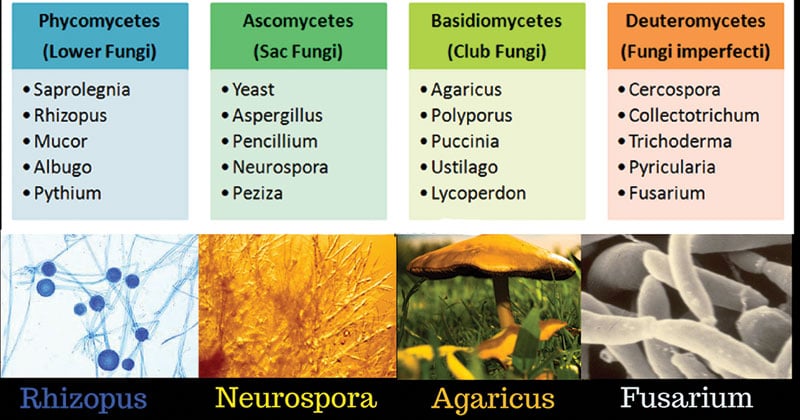Explain How Fungi Are Classified Into Different Groups
Hence they have an autotrophic mode of nutrition. Parasitic The fungi obtain their nutrition by living on other living organisms plants or animals and absorb nutrients from their host.
They are classified into five phyla namely Chytridiomycota Chytrids Zygomycota conjugated fungi the Ascomycota sac fungi Basidiomycota club fungi and Glomeromycota.

. Currently seven fungal divisions are proposed but we will discuss only four of them in detail. They are multi-cellular eukaryotes. Based on the morphology fungi are classified into four groups.
They are classified into five phyla namely Chytridiomycota Chytrids Zygomycota conjugated fungi the Ascomycota sac fungi Basidiomycota club fungi and Glomeromycota. The shape and internal structure of the sporangia which produce the spores are the most. Fungi are characterized by the absence of green pigment.
Tap card to see definition. What are the basis of classification of fungi explain. Fungi are divided into 3 main groups.
For this reason fungi are included within the field of. It seems likely that fungi are not a monophyletic group. Plantae is the plant kingdom which includes all plants on the earth.
Fungi reproduce by vegetative asexual and sexual methods. The fungi comprise a diverse group of organisms that are heterotrophic and typically saprozoic. Fungi are classified by their method of reproduction both sexual and asexual.
Currently fungi is classified into seven main groups. These phyla are Neocallimastigomycota Glomeromycota Ascomycota Microsporidia Chytridiomycota Blastocladiomycota and Basidiomycota. The Chytridiomycotachytrids Zygomycotabread molds Ascomycotayeasts and sac fungi and the Basidiomycotaclub fungi.
Some protists convert food into energy through photosynthesis as plants do. Asexually form at the tips of hyphae. In addition to the well-known macroscopic fungi such as mushrooms and molds many unicellular yeasts and spores of macroscopic fungi are microscopic.
On the basis of nutrition kingdom fungi can be classified into 3 groups. Sexually- Hyphae fuse joining a and - nucleus together many times the nuclei dont making a dikaryotic cell which develops and produces spores. The major divisions phyla of fungi have been classified based mainly on their sexual reproductive structures.
Thus the correct answer is option B. The phyla Zygomycota Basidiomycota Ascomycota and Chytridiomycota which are listed in the Classifications of Fungi Table. Placement into a division is based on the way in which the fungus reproduces sexually.
Thus the correct answer is option B. Saprophytic The fungi obtain their nutrition by feeding on dead organic substances. Most of them are heterotrophic.
Fungi are classified on the basis of sexual reproduction. -Protists are often classified by the characteristics that resemble those of fungi plants and animals. These can not synthesize organic food materials.
Rhizopus Penicillium and Aspergillus. An older classification scheme grouped fungi that strictly use asexual reproduction into Deuteromycota a group that is no longer in use. Historically they have been divided into four taxonomic divisions.
These derive their food either from dead ad decaying organic matter saprophytic mode of nutrition or from living host parassitc mode of nutrition. Zygomycota Ascomycota Basidiomycota and Deuteromycota. Fungi are usually classified in four divisions.
Yeasts Yeast -like Filamentous fungi Moulds Dimorphic Fungi 1. Two Hyphae of different mating types join together and produce a zygospore between them like a fertilized egg in animals. The plant kingdom is a vast group.
Therefore the kingdom is further classified into subgroups. Others move and consume food as animals do. Fungal spores are also resistant to many antibiotics chemicals ph temperature etc.
Fungi or funguses is any member of the group of eukaryotic organisms that includes microorganisms such as yeasts and molds as well as the more familiar mushroomsThese organisms are classified as a kingdom separately from the other eukaryotic kingdoms which by one traditional classification include Plantae Animalia Protozoa and. Phynomycetes Ascomycetes Basidiomycetes and Deuteromycetes. The reproduction of some protists resembles the reproduction of fungi.
Until the late 20 th century fungi were classified as plants and were divided into four groups. On the basis of cell type fungi are broadly classified into yeast and moulds. Vegetative methods include binary fission and budding.
What are the basis of classification of fungi explain. Fungi are classified on the basis of sexual reproduction. The five true phyla of fungi are the Chytridiomycota Chytrids the Zygomycota conjugated fungi the Ascomycota sac fungi the Basidiomycota club fungi and the recently described Phylum Glomeromycota.
These are heterotrophs ie. The Deuteromycota is an informal group of unrelated fungi that all share a common character they use strictly asexual reproduction. The five true phyla of fungi are the Chytridiomycota Chytrids the Zygomycota conjugated fungi the Ascomycota sac fungi the Basidiomycota club fungi and the recently described Phylum Glomeromycota.
Classify fungal organisms according to major groups. As the technology and science advanced scientists started realizing there are many other families of fungi and determined they are not plants. They consist of cell walls and chlorophyll.
These occur in form of round or oval bodies that reproduce by asexual process called buddingwhere the daughter c View the full answer.

Kingdom Fungi Characteristics Classifications Concepts Videos Q As

Ainsworth Classification Of Fungi Flow Chart With Example And Salient Features

Classification Of Fungi Gymnomycota Mastigomycota Amastigomycota
0 Response to "Explain How Fungi Are Classified Into Different Groups"
Post a Comment